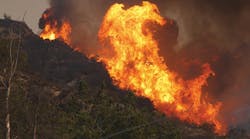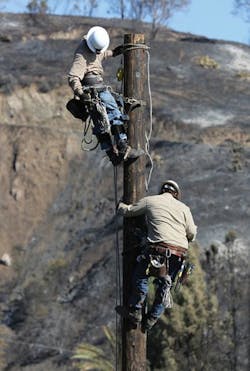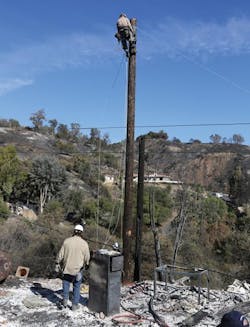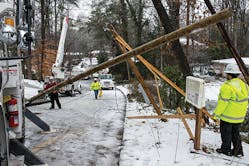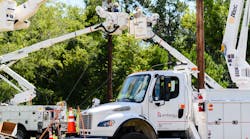To state a simple fact: Electric utility linemen are heroes and lifesavers. In the face of a wide range of severe weather and natural disasters, it is electric utility line crews who jump into action early — as soon as they can. They traverse fallen trees, surging rivers and smoldering forests to turn the lights back on and restore lifesaving electricity to health care facilities as well as lifesaving heating and cooling to businesses and residences alike.
The 2013-2014 period may not have been the worst extreme-weather stretch the U.S. has ever seen; in fact, in many areas of the country, the weather was relatively tame. No major hurricanes made continental landfall during the 2013 hurricane season — certainly nothing on the order of Hurricane Katrina or Superstorm Sandy. That said, as is always the case, extreme weather can hit at any time and often targets a very specific region. Over the course of the last 12 months, utility crews have truly been tested — and, of course, proved their mettle — in the face of numerous severe-weather incidents.
Burning Up
A relatively dry winter and strong Santa Ana winds in January 2014 kicked off the wildfire season earlier than usual in Southern California, with the first major wildfire of the year ignited in mid-January by an illegal campfire that blew out of control. The resulting Colby fire in the San Gabriel Mountains of northern Los Angeles County burned for about 10 days and covered 1,952 acres in total, causing the evacuation of some 3,600 people at its peak. It foreshadowed many more fires throughout Southern California by the end of May 2014.
Mike Lorusso is the district manager for the Covina Service Center of Southern California Edison (SCE) and was one of the first electric utility responders to the fire. He was on the freeway on a day off from work, driving to a golf tournament, when he received a call from another SCE manager telling him not to go far, as there might be a wildfire in his district. Lorusso said as he drove closer to the fire, he saw the smoke plume and realized it was in his district. “The fire was in the canyons just north of our district yard,” he noted, “so I turned around, came into the office and headed up there with Kermit Taggart, the grid operations supervisor.”
SCE personnel, though, first have to wait for a fire to clear before they are allowed to go in and perform damage assessment and restoration work. So, initially, utility observers simply watch from as close to the site as allowed and begin putting together damage-assessment teams to come in once a burn area is cleared.
In the case of the Colby fire, Lorusso’s team found around 20 poles burned out, some of which had to be replaced by helicopter since they were in difficult-to-access, high mountain terrain. Wire and transformers also were melted or damaged beyond repair because of high winds blowing ash, dust and smoke into even those that had escaped the flames.
The Colby fire may have been the kickoff to Southern California’s 2014 wildfire season, but the real action came in May. A heat wave early in the month and the aforementioned dry Santa Ana conditions combined with strong, seasonal winds to fan multiple wildfires in San Diego County. By mid-May, California fire officials said they had already dealt with 1,400 wildfires, twice the normal amount for that time of year. By early June, the number had climbed to 2,120 fires, causing in excess of $60 million in damage.
With all of this activity, 2014 has turned out to be a propitious year for SCE to debut its new Incident Command Services T&D restoration program.
In 2013, another wildfire hot spot was Arizona, where the Yarnell Hill fire resulted in the deaths of some 19 firefighters, the worst loss of life in a wildland fire in nearly 80 years. The Yarnell Hill fire was started by a lightning strike in late June 2013 and burned for about 12 days. It resulted in the complete evacuation of the towns of Yarnell (with a pre-fire population of about 700) and Peeples Valley, 80 miles northwest of Phoenix, Arizona.
Electric utility Arizona Public Service (APS) not only had to de-energize lines before the fire, but it also had to restore service to the towns once the blaze burned through. Travis Conner, a section leader for transmission maintenance and reliability from the Deer Valley complex of APS, said the fire surprised everyone with its ferocity and growth, starting small but soon enough “burning up the whole town,” cutting power to at least 450 APS customers.
“The town of Yarnell was about 90% wood poles. One of the reasons was because it is nestled in between some very large boulders, and we can’t climb the [steel poles],” Conner said. “We lost the majority of poles.
“Transformers exploded or melted from the heat; aluminum wire either melted, burned up or annealed,” Conner continued, explaining that annealed metal “becomes rubbery and bends back and forth,” and cannot continue to reliably and safely carry electricity.
Walking through the town of Yarnell a day or two after the fire, Conner said it felt like something between being on the surface of another planet and the scene of a disaster movie. “Everything was still smoldering and smoking,” he recalled. “It felt like going to a big crater on the moon. Everyone in the area had propane tanks, too. We had to wait for the fire guys to remove them or blow them up. So there were still some flames coming out of the ground from broken propane lines.”
The Yarnell Hill fire is far from Conner’s only experience with what Mother Nature can do to electric transmission and distribution systems. He cited monsoons in the middle of summer in Arizona, and he also was part of a mutual aid group that flew to Connecticut to help in post-Hurricane Sandy restoration. “Our everyday training supports all kinds of inclement weather,” Conner noted. “We are really good at our restoration efforts.”
A Storm Called Pax
It feels like the trend of naming winter storms is a relatively new one. If so, rarely has a moniker been further off than that hung on an ice storm that ravaged the northern half of Georgia in February 2014.
Dubbed “Winter Storm Pax” after the Roman goddess of peace, Pax was anything but a peaceful occurrence for the staff of Georgia Power. Featuring record-breaking cold, combined with snow and ice that accumulated to more than an inch thick on everything from roads to power lines, Pax literally brought down the house — well, the poles and wires at least — in a large portion of Georgia Power’s service territory. Hardest hit were south metro Atlanta and the far eastern city of Augusta.
Drew Stover, a power crew leader with Georgia Power, was actually called back from storm-restoration duty following a snowstorm in Pennsylvania to face off with Pax. “I have lived in Georgia all my life, and I have never seen this much ice at one time,” Stover commented. “It was just a lot of wind, snow and ice — all in just a few days.”
Once back in Georgia, and as the stormed moved out, Stover was assigned to one of the 16 line crew personnel teams that drove to Augusta, perhaps the hardest-hit area. “We had a state patrol and must have had a convoy of about 100 vehicles with tire chains on trying to drive through the ice,” he said. “We got assigned to a substation just outside of Augusta. It was still energized, but all the distribution was out for the whole station.”
Utility line devastation in ice storms is a result not only of the line icing up, but also of tree limbs icing up, getting heavy and falling across lines. Poles come down from vehicles skidding across icy roads and highways. Refreezing can cause even more problems when daytime temperatures are warm, followed by new ice formation that night or the next day.
All in all, by the time three-day-storm Pax had slid across Georgia, some 701,000 customers lost power, 375 poles had to be replaced, 2,800 strands of distribution wire had to be repaired, 630 distribution transformers had to be replaced and 44 transmission lines had to be restored. Power was restored to those more than 700,000 customers all within about four days.
The utility used an estimated 8,000 employees, contractors and personnel on loan from other utilities to perform this Herculean task, including setting up six major staging areas throughout the state, with contractors and employees housed at some 800 hotel rooms across 40 hotels, more than 42,000 meals served and more than 25 vehicles rented plus several passenger buses provided. Southern Company sister utilities Alabama Power, Gulf Power and Mississippi Power contributed as many linemen as they could. “It was pretty amazing,” Stover said. “We had over 8,000 people working this storm, and you have to have somewhere for them to get material and have them ready to go when and where needed. It was really very impressive.”
Gone in an Instant
Wildfires burn fast, but they can linger and leave charred devastation in their wake. Ice storms wreak their silent though deadly damage on utility lines and poles, burdening trees with their weight and often hanging in there with days or even weeks of freezing temperatures to seal their grip. A tornado, however, does its damage in mere seconds — sometimes as long as minutes, but often fractions of minutes — and can tear apart both houses and electrical equipment in a literal instant.
That is what happened in Arkansas on April 27, 2014, when the first twister of 2014 to earn an EF4 designation — wind speeds between 166 mph and 200 mph — tore through central Arkansas, leaving a 41-mile-long, half-mile-wide path of destruction just north of Little Rock. On the ground for nearly an hour, the storm killed 16 and caused an estimated $90 million to $120 million in damages to utility infrastructure, according to Entergy Arkansas CEO Hugh McDonald. Among the casualties was the Mayflower substation, one of three main substations that provides power to Little Rock and its suburbs.
Adrian Greene, a distribution line supervisor for Entergy Arkansas, saw the damage firsthand. He was actually in Kansas City, Missouri, the weekend the tornado hit, but he hustled back to Arkansas at the first sign of damaging weather back home. “We dispatched limited resources when the storm hit Sunday, and by Monday morning, it was full threads in,” Greene recounted. “Everybody was here to help.”
The utility jumps into action in several ways when a storm hits, according to Greene. First, the utility identifies and assesses the damage. Next, it acts as quickly as it can to restore power to life-safety and public-safety locations, such as hospitals, nursing homes, emergency call centers, fire and police stations, pumping stations for municipal water treatment and the like. Next to or simultaneously with that, the utility works to find alternate routes for power to avoid any damaged substations.
The goal is to restore power as rapidly as possible while keeping workers and the public safe; thus, it is more efficient to isolate a damaged substation or feeder, find a new route for the power and come back to make repairs later.
With the help of an estimated 100 staff and 400 outside contractors, Entergy Arkansas was able to restore power to all who could take power — that is, their homes or businesses were not completely leveled or damaged beyond repair — by the Thursday following Sunday’s twister. Based on the damage he saw, Greene considered it a “tremendous accomplishment” to get everyone back on-line within four days. All in all, he said, the utility managed to replace 673 poles, 193 crossarms and 207 transformers over those four days, helping to restore power to more than 11,000 customers affected by the storm.
The restoration effort was helped by relatively calm, good weather in the days after the tornado but also involved repair challenges unique to tornadoes. “One of the subdivisions that was hit had a lot of underground cable, but the tornado moved padmount transformers and relocated switchgear off of those pads,” Greene pointed out, adding that the force of the winds were such that residents reported debris being picked up in the tornado touchdown area and dropped to the ground again some 150 miles north, near the Missouri border.
Of Human Kindness
Electric utility linemen are heroes and lifesavers during and after major storms, it is true. But every lineman also will say they are only able to do what they do with the help of dedicated, hardworking teams behind them to arrange the logistics, vehicles, equipment, tools, work schedules and other considerations that go into successful electrical service restoration following a storm.
They also will point out the genuine goodness and human kindness that comes from shared tragedy. “We are really just out here trying to help people,” said Stover of Georgia Power. “But, still, it’s humbling to see how people go out of their way to help us. They bring us water, coffee, a few snacks. We get invited in for supper.”
Linemen who live in wildfire areas often tell stories of having to evacuate their own homes while reporting to duty to fight either that fire or a neighboring blaze. Ice storms and tornadoes also do not magically skip linemen’s houses, nor those of their friends, family and neighbors. Yet, in the lineman’s world, the key goal after a storm is to restore power as quickly and widely as possible, all while observing the necessary safety precautions and procedures.
“You hear a lot about the bad stuff in the world,” said Henry Matthew Linck, a senior lineman with Entergy Arkansas who worked alongside Greene in post-tornado power restoration in April and May 2014. “But then something like this hits, and everyone pitches in and puts things back together again. People come from all over the U.S. to help out. Some have specialties and some don’t. It can be as simple as helping pick up and move debris. It is all just a very good team effort, and it really makes you feel good.”
